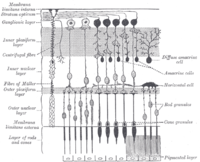
Photo from wikipedia
Interleukin-2 (IL-2) is a classical pro-inflammatory cytokine known to display neuroprotective roles in the central nervous system including the retina. In the present study, we investigate the molecular targets involved… Click to show full abstract
Interleukin-2 (IL-2) is a classical pro-inflammatory cytokine known to display neuroprotective roles in the central nervous system including the retina. In the present study, we investigate the molecular targets involved in the neurotrophic effect of IL-2 on retinal ganglion cells (RGC) after optic nerve axotomy. Analysis of retrograde labeling of RGC showed that common cell survival mediators, as Trk receptors, Src, PI3K, PKC, and intracellular calcium do not mediate the neurotrophic effect of IL-2 on RGC. No involvement of MAPK p38 was also observed. However, other MAPKs as MEK and JNK appear to be mediating this IL-2 effect. Our data also indicate that JAK2/3 are important intracellular proteins for the IL-2 effect. Interestingly, we demonstrate that the IL-2 effect depends on dopamine D1 receptors (D1R), the cAMP/PKA pathway, interleukin-10 (IL-10), and NF-κB, suggesting that RGC survival induced by IL-2 encompasses a molecular network of major complexity. In addition, treatment of retinal cells with recombinant IL-10 or 6-Cl-pb (D1R full agonist) was able to increase RGC survival similar to IL-2. Taken together, our results suggest that after optic nerve axotomy, the increase in RGC survival triggered by IL-2 is mediated by IL-10 and D1R along with the intracellular pathways of MAPKs, JAK/STAT, and cAMP/PKA.
Journal Title: Neurochemical research
Year Published: 2021
Link to full text (if available)
Share on Social Media: Sign Up to like & get
recommendations!